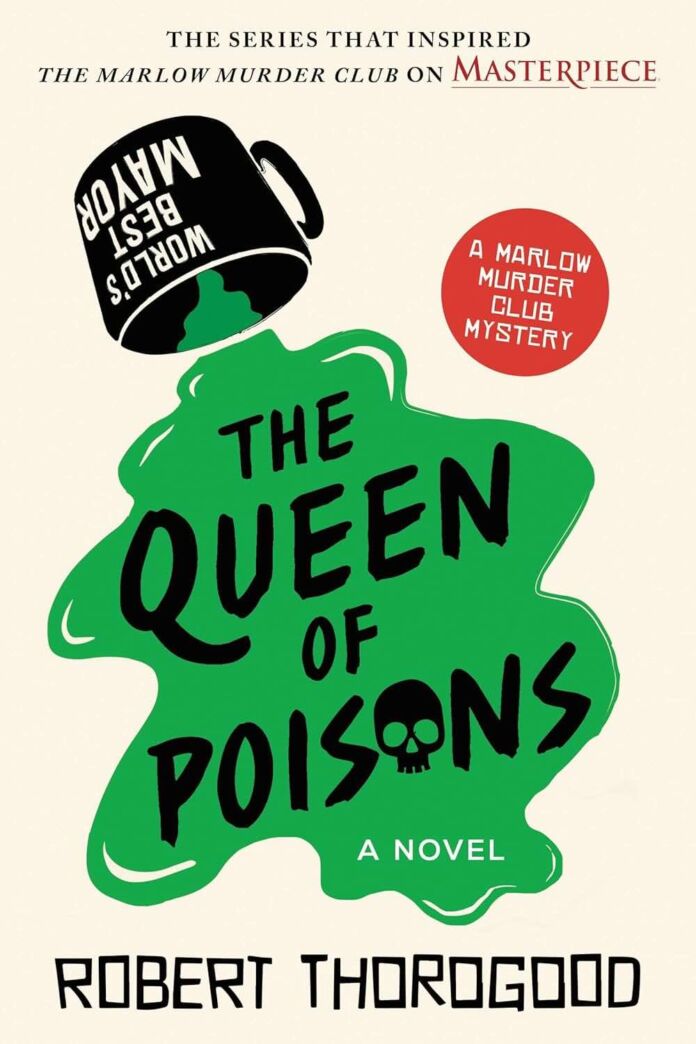The Queen of Poisons is the third installment in Robert Thorogood’s delightful Marlow Murder Club series, following The Marlow Murder Club and Death Comes to Marlow. In this latest addition, Thorogood delivers another intricately plotted mystery that combines clever detective work with charming humor and authentic small-town dynamics.
The Essence of the Story
Set in the picturesque Thames-side town of Marlow, the story begins with an apparently ordinary town council planning meeting that turns deadly when Geoffrey Lushington, the beloved Mayor of Marlow, suddenly collapses and dies after drinking his coffee. When traces of aconite—known as the queen of poisons—are found in his cup, what initially seemed like a tragic accident becomes a murder investigation.
What sets this book apart is how Detective Inspector Tanika Malik immediately brings in our trio of amateur sleuths—Judith Potts (a septuagenarian crossword setter), Suzie Harris (a dog walker with entrepreneurial dreams), and Becks Starling (the vicar’s wife) – as official civilian advisors. This early involvement allows readers to follow the investigation from the very beginning, creating a more immersive experience than in previous books where the trio had to work their way into the cases.
Character Development and Dynamics
Thorogood excels at character development, particularly in his portrayal of the three main protagonists. Judith Potts remains the heart of the series – eccentric, intelligent, and delightfully unconventional. Her habit of swimming naked in the Thames and her determination to solve crosswords and murders with equal vigor makes her an unforgettable character.
The friendship between the three women continues to evolve naturally, with each bringing their unique perspectives and skills to the investigation:
- Judith’s analytical mind and fearless approach to questioning suspects
- Suzie’s local knowledge and practical street smarts
- Becks’ understanding of the town’s social dynamics and ability to smooth over awkward situations
Plot Complexity and Pacing
The mystery itself is masterfully constructed, with multiple layers of deception and red herrings. The author plants clues throughout the narrative that seem insignificant at first but prove crucial to solving the case. The revelation of the killer’s identity is particularly well-executed, with a solution that is both surprising and logically satisfying.
Strengths and Notable Elements
Innovative Narrative Techniques
Thorogood employs several clever narrative devices that enhance the story:
- The use of artifacts (like the mysterious letters and surveillance footage)
- The integration of modern technology with traditional detective work
- The parallel investigation of multiple suspects, each with their own secrets
Setting and Atmosphere
The author’s intimate knowledge of Marlow shines through in his detailed descriptions of the town and its inhabitants. The setting becomes more than just a backdrop; it’s an integral part of the story that influences how events unfold and how characters interact.
Areas for Improvement
While the book is generally well-crafted, there are a few aspects that could have been stronger:
- Some of the secondary characters’ motivations feel slightly underdeveloped
- Certain plot points rely perhaps too heavily on coincidence
- The pacing in the middle section occasionally slows more than necessary
Writing Style and Tone
Thorogood’s writing style remains engaging and accessible, with a perfect balance of humor and tension. His ability to shift between light-hearted moments and serious investigation keeps readers invested throughout the story.
Series Progression
The Queen of Poisons builds effectively on its predecessors while maintaining its own distinct identity. Readers familiar with The Marlow Murder Club and Death Comes to Marlow will appreciate the continued character development and the deepening relationships between the main characters.
The upcoming fourth book, Murder on the Marlow Belle, promises to continue this strong trajectory, suggesting that Thorogood has plenty more stories to tell in this charming setting.
Comparative Analysis
When compared to similar series in the genre, such as Richard Osman’s Thursday Murder Club or M.C. Beaton’s Agatha Raisin mysteries, the Marlow Murder Club series distinguishes itself through its unique blend of traditional detective work and modern sensibilities. The friendship between the three main characters feels more organic and less contrived than in many comparable series.
Technical Elements
Research and Authenticity
The author’s research into poisons, particularly aconite, adds credibility to the plot. The technical details about police procedure and forensic evidence are well-integrated without becoming overwhelming.
Dialogue and Character Voice
Each character maintains a distinct voice throughout the narrative, making conversations feel natural and authentic. The banter between the main characters is particularly well-written, revealing their personalities and relationships through casual interactions.
Final Verdict
The Queen of Poisons is a worthy addition to the Marlow Murder Club series that will satisfy both longtime fans and newcomers to the series. While not perfect, its strengths far outweigh its minor flaws.
Who Should Read This Book
This book is perfect for readers who enjoy:
- Traditional British mysteries with a modern twist
- Strong female protagonists
- Character-driven narratives
- Small-town settings with complex social dynamics
- Clever plot twists and satisfying resolutions
Reading Order Recommendation
While the book can be enjoyed as a standalone, readers will get the most satisfaction from reading the series in order:
- The Marlow Murder Club
- Death Comes to Marlow
- The Queen of Poisons
- Murder on the Marlow Belle (upcoming)
This allows for full appreciation of the character development and evolving relationships that make this series so engaging.
In conclusion, The Queen of Poisons is a skillfully crafted mystery that combines intelligent plotting with warm humor and genuine heart. It’s a testament to Thorogood’s growing mastery of the genre and his ability to create compelling, memorable characters who feel like old friends by the end of the book.





